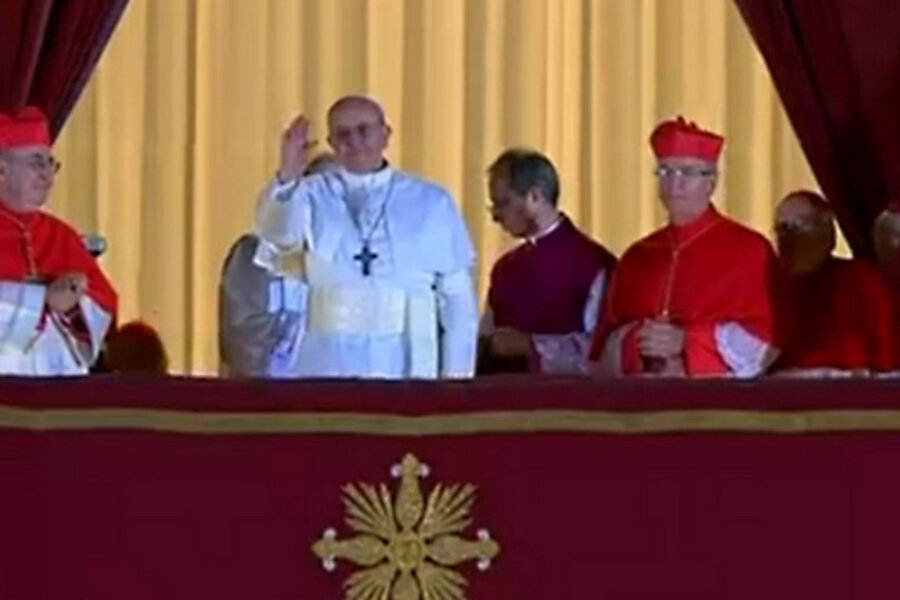Pope Francis I elected, would you name your child Francis?
Loading...
When Jorge Mario Bergoglio won the papal conclave's vote for new pope today (March 13), he also announced his new name: Francis I, or Francesco I in Latin.
The name is a reference to Saint Francis of Assisi, a venerated Catholic friar who lived in the 13th century. Saint Francis is patron saint of animals and the environment. He was known for his dedication to poverty and reform, which may send a signal about the new pope's concerns.
But popes didn't always pick a papal moniker, also known as a regnal name. And today, they rarely get overly creative with the choice.
In other words, while Americans are increasingly in search of unique baby names, don't expect to see a Pope Jayden or Pope Phoenix anytime soon.
"In one sense, this is the most tradition-bound of naming decisions," wrote Laura Wattenberg, a baby-naming expert, on her blog Baby Name Wizard. "The name must be a deep and pure reflection of Catholic history and values."
A history of papal names
The first pope to rename himself was Pope John II, who headed the Catholic Church from A.D. 533 to A.D. 535.
John II was born Mercurius, a name that honored the Roman god Mercury. The new pope felt that a name derived from Roman mythology wasn't appropriate for the head of Christianity, so he decreed that he would henceforth be the appropriately Biblical John II. [Papal Primer: History's 10 Most Intriguing Popes]
Not every pope followed suit, but most popes began picking regnal names for themselves by the 10th century. Pope Marcellus II was an exception to the rule — elected in 1555, he kept his birth name, more or less. (Marcellus II was born Marcello Cervini degli Spannochi.) No pope since has kept his birth name.
Naming today's popes
Want to raise a pope? While a baby name may not do the trick, if you wanted to stick with pope-ly ways, you'd be smart not to get creative with naming choices. According to Wattenberg, four names (John, Benedict, Gregory and Clement) have accounted for 55 of the 129 popes who have ruled since re-naming became the norm.
Nevertheless, names send strong signals, Wattenberg wrote. Cardinal Albino Luciani named himself John Paul I after the two popes before him, a choice widely seen as a statement of continuity.
Sometimes popes aim for a moniker more humble than their birth name. Pope Sergius IV (1009-1012) was born Pietro, or Peter, a name that harkened back to the Church's first Pope, Saint Peter.
In other cases, naming conventions get a bit odd. There has been a Martin I, Martin IV and a Martin V, but no Martin II or III. That's because two popes named Marinus were mistakenly recorded as Martins by some sources, mixing up the numbering system.
Popularity of pope names
Pope naming conventions don't track well with American naming trends, which skew toward increasingly less popular (yet still trendy sounding) names. In the 1880s, John was the No. 1 boy's name in the United States. By 2011, it had slid to No. 27. Even popular baby names no longer account for the same proportion of names as they used to; about 40 percent of boys in the 1880s bore one of the top 10 names. Today, fewer than 10 percent do, according to a 2010 study.
Gregory ranked as the 279th most-popular boy's name in 2011; neither Clement nor Benedict made the top 1,000.
The new pope's name, Francesco in Latin or Francis I, is a first for papal names. The name Francesco did not rank above 1,000 before 1960 or after 2000 for baby boys born in the United States, but it did reach the rank of 863 in the 1980s. Francis peaked in popularity in the United States in 1910, when it ranked 31st for boys. As of 2011, the name ranked No. 618 in names for baby boys.
Follow Stephanie Pappas @sipappas. Follow LiveScience on Twitter @livescience, Facebook or Google+. Original article on LiveScience.com.
- 8 Ways Religion Impacts Your Life
- 6 Strange Facts About Choosing a New Pope
- Saint or Spiritual Slacker? Test Your Religious Knowledge
Copyright 2013 LiveScience, a TechMediaNetwork company. All rights reserved. This material may not be published, broadcast, rewritten or redistributed.







